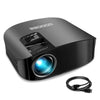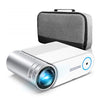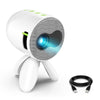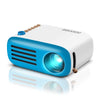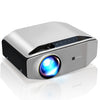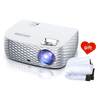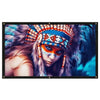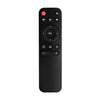
Projector Buying Guide: 5 Things to Consider Before Buying One
Whether you want to feel the thrill of high-resolution movies, level up your gaming experience, or want to see your slideshows or presentations on a bigger screen, a projector is your go-to solution. No doubt, a smart TV can deliver HD content. But the best projectors can easily at par with its resolution—only better and bigger. Not to mention you can bring the device anywhere, whenever.
With so many brands available today, it’s quite confusing on how to pick a projector that outputs optimal performance. Although there are dozens out there who claim to be the best, you still need to fact-check the details. Or weigh the options and evaluate the price.
Remember, any presentation or movie can turn into an ultimate visual experience with the best projector in the market. If you’re ready to own one or still canvassing info on what’s the real deal today, here are our five things to consider before choosing a projector.
-
What kind of projector do I need?
First things first, you have to know what and how the device works. A projector is a device that is used to project light out of a lens onto a flat surface (or more like an inverted camera). Projectors help create an image through rays of light by a transparent lens. Some systems use LED or metal halide for light sources.
If you want portability and larger screen size, then a projector is your must-have. However, projectors must not be used as a medium for video correction, or such as color evaluation. These devices only work best for visual presentations or home theater. Also, you have to maintain a low light to project the screen—so colors could pop up better.
For our projector buying guide, here we’ll explain the top five types of digital projector namely, Multimedia, Mini Projector, Home Theater Projectors, the Short Throw/Ultra Short Throw Projectors, and Fixed-Installation/Large-Venue Projectors.
Multimedia projectors are considered as the most sold devices—and are also widely used for general purposes. From weddings, slideshows, to PowerPoint presentations, multimedia projectors are simply light-weight and compact. They are typically connected to VCRs, DVD Players, and cable boxes that mostly weigh less than 3 lb. It’s a centerpiece for classrooms, auditoriums, conference rooms, etc. since they are a great use for frequent presentations.
Mini Projector
Also known as Pocket Projector, they are best recognized as an alternative for a computer monitor or mini TV that you can take anywhere with you. Their key function is portability. That’s why they normally use LED lamps (for low power consumption) and compact cooling technology (to avoid overheat). However, the downside is that they don’t have optical zoom, which means you need to adjust the projector’s position to get the desired screen size.
Palm-sized and stylish, the Goode YG220 Portable Mini Projector can also support 1080P with a native resolution of 480*320P. While the GooDee YG200 Pico Mini Power Bank is a mini projector equipped with smart charging and built-in speaker.
Home Theater Projectors
If you want the full package, combining high resolution (Full HD), high brightness, great color accuracy, and maximum screen size of up to 100 inches, home theater projects are made just for that. Their built-in lenses have the most zoom—and run lower brightness of average. Although they cost a lot, the features and functionality of this kind of projector can deliver optimal performance.
Home Theater Projectors are equipped with the best tech cooling system to run the gear without the slightest noise possible. The Goode YG601 Updated LCD Home Theater 1080P Supported Projector is a powerful beast projector that provides superior brightness and clarity than any home theater projectors available today.
Short Throw/Ultra Short Throw Projectors (a subset of multimedia projectors)
For big images with small spaces, the short-throw projectors are your ideal solution. It can create a wide size image on a wall from a short distance. Unlike other projectors, it can sit up against the wall for within 3 to 4 inches, and can still project a larger 100-inch image; however, its features and performance are not equal with other cutting-edge projectors.
Almost all short throw projects have no zoom lenses included. Most of these are mounted to the wall rather than the ceiling and can deliver a throw ratio of less than 1:1.
Large-venue Projectors
Also, part of the multimedia projectors, these are the brightest systems that could run around with a screen size of up to 100 inches. These are seriously used for large spaces such as churches, movie theaters, lecture halls, and other areas where the light is uncontrollable. Since it takes a bit more work and knowledge, only the professionals could set up and install this system.
Understand what kind of environment you want to mount your projector. Note that there is a specific projector for specific purposes that would work best. Before choosing one, ask yourself, “Where do I need this projector for? Is it for the classroom? Lecture hall? Or larger venue?” And “Do I frequently need it? Will I use it just for movies?” Nonetheless, you still have to get a grasp of what ratio and throw distance mean, as well as the resolution.
-
What screen size and throw distance should I get? Since you’re now familiar with the types of projector, you need to understand what screen size and throw distance you need. In this case, a throw distance is estimated through the distance between the projector and the screen image. There are two types of common throw distances.
Short Throw. Mostly applicable for projectors installed on the wall or ceiling close to the wall. Normally with a distance of 3 to 8 feet away from the installed projector to screen.
Ultra-Short Throw. This works for a distance between 0 to 4 feet away from the mounted or placed projector to screen.
If you’re still in doubt, you can try this projector screen calculator to determine your desired ratio and throw distance.
-
What resolution is the best for my projector?
Typically, the most recommended resolution is at WXGA (1280 x 800), a widescreen format that could also provide a 4:3 standard aspect ratio. Although several projectors today have XGA (1024 x 768) resolution, this is not a good choice since the image quality could be visibly pixelated. Well if you’re trying to save a fortune, you can pick the relatively low resolution SVGA 800x600 that could deliver satisfactorily.
Start with the WXGA resolution for presentations and home theater options. But if you want to opt into 4K, you can stick to the FULL HD (1920 x1080) to experience the full entertainment.
-
What kind of connectivity or cable does my projector need?
There’s a bunch of projector connections you can connect to the various input devices in your system. Getting familiar with these cables and dongles will help make you a smarter and efficient choice.
MHL support (Mobile High-Definition Link) It was designed for a mobile audio/video interface that features 8k video at 120 fps (frames per second). It allows a connection of mobile devices to TVs and projectors.
HDMI (High Definition Multimedia Interface). Perfect for home cinema installations via one single cable that outputs video (up to 4K UHD resolution), audio, and data.
VGA (Video Graphics Array Cables). Use for PC and display devices, this is a cable that only transmits video signal. The cable contains 15 unique pins—and each with a distinct function for display.
DVI (Digital Video Interface Cable). A cable that features three types namely, analog, digital, and DVI-A (DVI-D and DVI-I), can only transmit the video signal.
S-Video. A display cable that is rarely used today for transmitting video display. Also known as SVHS, Y/C, and Mini DIN.
Composite Video. Considered as the lowest quality cable for the video source, these cables can transmit up to 480i or 576i only.
Ethernet (Network Cable). The most reliable cable for connecting Local Area Network (LAN) which can link a PC to another PC. They can transmit audio, data, and video.
Display Port. Unlike older cables, DP has a larger data transfer speed which means it can transmit video, audio, and data with up to 34Gbps (or can deliver 8K resolution images).
Wireless HDMI. Normally comes with a USB dongle, it has 30-foot range projector wireless dongles. If you prefer a wireless adapter, then you can try this one.
-
Do I need a separate speaker for my projector?
The built-in speakers in the projector won’t suffice. It’s advisable to purchase a decent one that could help level up the visual and audio experience. Although you still want the full package of great video and sound, the Goodee YG500 Movie Projector can handle both what you’re looking for. It has a powerful built-in 2W speaker that provides stunning high-quality sound compare to standard projectors.
In a nutshell, there are tons of other things, features, or needs to consider before buying a projector. Kick start first with a few reasons why you need to buy one. Is it for entertainment? Business? Or do you need it for home or camping? Outdoor or indoor? What features are the most crucial for you? And from there, you can imagine how the device could actually help you or entertain you. if in doubt, ask for a techie friend—who maybe already bought one—for a projector buying guide or advice.


